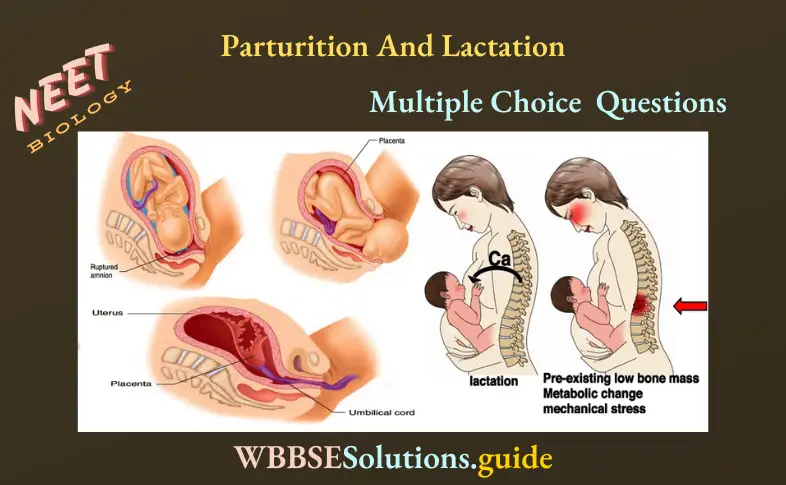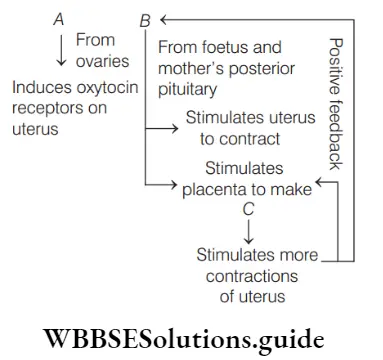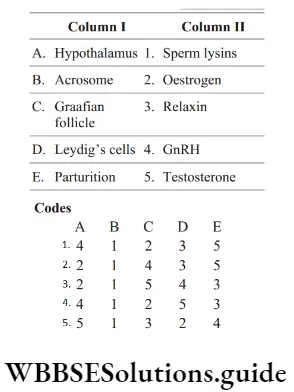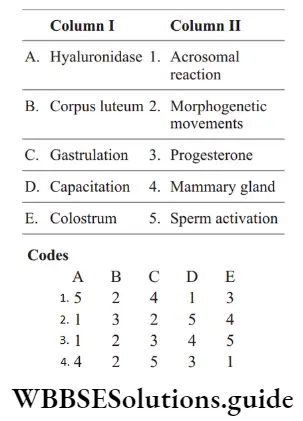Biology MCQs with answers for NEET Parturition And Lactation
Question 1. The process of delivery of foetus is called
- Parturition
- Implantation
- Fertilisation
- Lactation
Answer: 1. Parturition
Parturition is the process of giving birth to young one or the delivery of foetus.
Question 2. The baby ready for birth weighs about
- 2.7 to 4.5 kg
- 1.2 to 2.5 kg
- 4 to 6 kg
- 3.5 to 5 kg
Answer: 1. 2.7 to 4.5 kg
The average birth weight of a human baby is about 2.7 to 4.5 kg.
Read And Learn More: NEET Biology Multiple Choice Question And Answers
Question 3. Assertion Parturition is induced by neural signal in maternal pituitary. Reason (R) At the end of gestation period, the maternal pituitary releases prolactin which causes uterine contractions.
- Both A and R are true and R is the correct explanation of A
- Both A and R are true, but R is not the correct explanation of A
- A is true, but R is false
- Both A and R are false
Answer: 4. Both A and R are false
- Both A and R are false and can be corrected as Parturition is induced by a complex neuroendocrine mechanism. The signals for parturition originate from the fully developed foetus and the placenta. These induces mild uterine contractions called foetal ejection reflex.
- This triggers the release of oxytocin from the maternal pituitary. Oxytocin acts on the uterine muscles and causes stronger uterine contractions.
“human reproduction mcqs class 12 “
Question 4. Parturition may be divided into …………… stages.
- 2
- 3
- 4
- 5
Answer: 2. 3
Parturition is divided into three stages namely, dilation, expulsion and placental.
Biology MCQs with answers for NEET

NEET Biology Parturition and Lactation MCQs with answers
Question 5. The first stage of parturition lasts for about
- 12 hours
- 20 min
- 45 min
- 60 min
Answer: 1. 12 hours
The first stage of parturition, i.e. dilation lasts for about 12 hours.
Question 6. During the second stage of parturition,
- Amnion and chorion rupture
- Placenta, umbilical cord and foetal membrane are expelled
- The umbilical cord is ligatured at two places close to the baby
- The foetal placenta is pulled out from the uterine wall
Answer: 3. The umbilical cord is ligatured at two places close to the baby
The umbilical cord is ligatured at two places close to the baby during the second stage of parturition, i.e. expulsion.
Question 7. In which stage of parturition, the contraction of the uterus close the cervix and prevents excess bleeding?
- 1st stage–dilation
- Expulsion
- Placental stage
- All of these
Answer: 3. Placental stage
In the placental stage of the parturition, the contraction of the uterus close the cervix and prevents excess bleeding.
Question 8. During dilation stage of parturition,
- Amnion and chorion rupture
- Amniotic fluid passes out
- The foetal placenta is pulled out from the uterine wall
- All of the above
“what is true for cleavage “
Answer: 4. All of the above
- During the dilation stage of parturition, the cervix widens and opens to about ten centimeters, so as to allow the passage of the baby.
- The amnion and chorion ruptures, amniotic fluid passes out and the foetal placenta is pulled out from the uterine wall.
Thus, option 4 is correct.
Biology MCQs with answers for NEET
Question 9. What changes take place in the foetus before parturition?
- The foetus grows up to 70 cm
- The foetus settles in head downward position in the pelvic cavity
- The foetus develops bluish-pink pigmentation
- The nervous system of foetus develop fully
Answer: 2. The foetus settles in head downward position in the pelvic cavity before parturition.
Important MCQs on Parturition and Lactation for NEET
Question 10. Which hormone is responsible for relaxing the ligaments of pelvic girdle?
- Relaxin
- Oxytocin
- Progesterone
- Prostaglandin
Answer: 1. Relaxin
The hormone relaxin relaxes the ligament of the pelvic girdle for the easy birth of the baby.
Question 11. Consider the following statements.
- Relaxin is secreted in the early stages of pregnancy.
- Relaxin prevents the dilation of uterus.
Choose the correct option.
- Statement 1 is correct, but 2 is incorrect
- Statement 1 is incorrect, but 2 is correct
- Both statements 1 and 2 are correct
- Both statements 1 and 2 are incorrect
Answer: 4. Both statements 1 and 2 are incorrect
- Both statements 1 and 2 are incorrect and can be corrected as Relaxin is a hormone secreted by the corpus luteum and the placenta in the terminal stage of pregnancy.
- It causes the cervix (neck) of the uterus to dilate and prepares the uterus for the action of oxytocin during labour (parturition).
Question 12. The foetal hormones accumulate in the mother’s blood till they cause
- An increase in progesterone and prostaglandins
- A decrease in progesterone and increase in prostaglandins
- An increase in progesterone and decrease in prostaglandins
- Decrease in progesterone and prostaglandins
Answer: 2. A decrease in progesterone and increase in prostaglandins
There is a decrease in progesterone and increase in prostaglandins when foetal hormones accumulate in the mother’s blood. It helps to promote uterine contractions and progress to labour.
“diagrammatic sectional view of male pelvis showing reproductive system “
Question 13. Name A, B and C hormones in the given figure.

- A–Prostaglandin, B–Oxytocin, C–Oestrogen
- A–Oestrogen, B–Oxytocin, C–Prostaglandin
- A–Oestrogen, B–Prostaglandin, C–Oxytocin
- A–Prostaglandin, B–Oestrogen, C–Oxytocin
Answer: 2. A–Oestrogen, B–Oxytocin, C–Prostaglandin
NEET quiz on Parturition and Lactation with solutions
Question 14. …………… is injected by doctors to induce delivery.
- Inhibin
- Oxytocin
- Oestrogen
- Prolactin
Answer: 2. Oxytocin
Doctors inject oxytocin hormone for the strong contraction of uterine wall, so as to induce labour pains.
Biology MCQs with answers for NEET
Question 15. In human adult females, oxytocin
- Stimulates pituitary to secrete vasopressin
- Causes strong uterine contractions during parturition
- Is secreted by anterior pituitary
- Stimulates growth of mammary glands
Answer: 2. Causes strong uterine contractions during parturition
In human adult female, oxytocin released by the pituitary gland (neurohypophysis) causes contraction of the uterus during labour and stimulates milk ejection from the breasts by causing the contraction of muscle fibres in the milk ducts.
Question 16. Which of the following hormones initiate parturition?
- ACTH, hCG, oxytocin
- ACTH, corticosteroid, oxytocin
- Corticosteroid, ACTH, prostaglandin
- ACTH, progesterone, hCG
Answer: 2. ACTH, corticosteroid, oxytocin
ACTH, corticosteroid and oxytocin initiate the parturition process in humans.
NEET expected MCQs on Parturition and Lactation 2025
Question 17. Reduced progesterone allows the secretion of ……………… hormone.
- ACTH
- FSH
- STH
- oxytocin
Answer: 4. oxytocin
At the end of gestation period, oxytocin hormone is released from hypothalamus and stored in posterior part of pituitary. It is then released in the blood stream when the level of progesterone decreases.
Question 18. ACTH causes the release of corticosteroid hormone from ………… of foetus.
- Adrenal glands
- Ovary
- Kidney
- Thyroid
Answer: 1. Adrenal glands
ACTH stimulates the adrenal glands to release the corticosteroid hormone in foetus during parturition. It helps in the lung maturation of foetus.
Question 19. The foetal-ejection reflex in humans triggers release of
- Oxytocin from maternal pituitary
- Oxytocin from foetal pituitary
- Human Chorionic Gonadotropin (hCG) from placenta
- Human Placental Lactogen (hPL) from placenta
Answer: 1. Oxytocin from maternal pituitary
Foetal-ejection reflex triggers the release of oxytocin from the maternal pituitary. Oxytocin acts on uterine muscles and causes strong contractions.
“hormones secreted by placenta “
Question 20. Match the following columns.

Answer: 4. A-4, B-1, C-2, D-5, E-3
NEET Biology Parturition and Lactation MCQs with explanations
Question 21. Secretion of milk by mammary glands is known as
- Lactogenesis
- Galactopoesis
- Galactogenesis
- Glucogenesis
Answer: 1. Lactogenesis
Lactogenesis is the process of secretion of milk from the mammary glands.
Question 22. Lactation begins
- Towards the end of pregnancy
- Towards the beginning pregnancy
- Towards the beginning of puberty
- Throughout the life cycle
Answer: 1. Towards the end of pregnancy
Lactation in human female begins towards the end of pregnancy.
Biology MCQs with answers for NEET
Question 23. Galactopoiesis means
- Secretion of milk
- M of milk secretion
- Discharge of milk from mammary glands
- Both 1 and 2
Answer: 2. M of milk secretion
Galactopoiesis refers to the maintenance of milk secretion. It is regulated by thyroxine and cortisol.
Question 24. Milk secretion is regulated by
- Increased secretion of progesterone
- Increased secretion of oestrogen
- Increased secretion of prolactin
- Increased secretion of relaxin
Answer: 3. Increased secretion of prolactin
Milk secretion is regulated by increased secretion of prolactin hormone which is released from the anterior pituitary.
Mock test on Parturition and Lactation for NEET preparation
Question 25. Milk secreted from the cells of alveoli of mammary lobes reaches to the nipple. Identify the order that it follows by passing through Lactiferous Duct (L), Mammary duct (M), Mammary Tubule (T) and Mammary Ampulla (A).
- TAML
- TMAL
- MTAL
- ATML
Answer: 2. TMAL
Route of milk secretion is Mammary Tubule (T), Mammary Duct (M), Mammary Ampulla (1), Lactiferous Duct (L), i.e. TMAL.
Question 26. First milk produced after childbirth is called
- Sebum
- Cercumen
- T milk
- Colostrum
Answer: 4. Colostrum
- The milk that comes out of the mammary glands during the initial days of lactation is called colostrum.
- It contains antibodies and nutrients for the baby. Thus, breast feeding is recommended by doctros for bringing up a healthy baby.
Question 27. Colostrum plays an important role for newborn babies as
- Colostrum have antigen
- Colostrum have antibody
- Both 1 and 2
- Colostrum have more nutrients than ordinary milk
Answer: 2. C have antibody
Colostrum contains antibody-A (IgA), which protects against the pathogenicity in newborn.
Biology MCQs with answers for NEET
Question 28. The type of sugar found in breast milk is
- Glucose
- Sucrose
- Lactose
- Galactose
Answer: 3. Lactose
Milk produced in human females contains proteins like casein, lactalbumin, etc., fat, lactose sugar, vitamins, mineral salts and water. It is poor in iron and has a very small quantity of vitamin-C.
Question 29. Milk of lactating mother is composed of
- Na+ and Ca2+
- Water and fats
- Sugars and proteins
- All of the above
Answer: 4. All of the above
Human breast milk is composed of carbohydrates, fats, proteins, vitamin water, sugar and minerals along with sodium, calcium, antibodies, enzymes.
Thus, option 4 is correct.
NEET practice test on Parturition and Lactation
Question 30. Identify the correct statements.
- Increased secretion of prolactin initiates milk formation
- Prolactin inhibits release of LH
- Suppression of menstrual cycle at the time of lactation
- All of the above
Answer: 4. All of the above
“human reproduction class 12 important questions pdf “
All given statements are correct. Increased secretion of prolactin initiates milk formation. Prolactin inhibits the release of LH and suppression of menstrual cycle at the time of lactation. Thus, option 4 is correct.
Biology MCQ For NEET With Answers
Question 31. Match the following columns with correct combination.

Answer: 2. A–1, B–3, C–2, D–5, E–4
Question 32. The time period of development of embryo in uterus
- Gestation
- Incubation
- Implantation
- None of the above
Answer: 1. Gestation
The time period from the start of pregnancy till parturition is called gestation.
Question 33. Human pregnancy lasts for ………… days from the start of the last menstrual cycle.
- 266
- 300
- 280
- 225
Answer: 3. 280
The average length of human gestation is 280 days or 40 weeks, from the first day of the woman’s last menstrual period.
“neetprep reproduction in organisms “
Question 34. Exact time of human gestation period is
- 9 month ± 15 days
- 9 month ± 20 days
- 9 month ± 7 days
- 9 months ± 1 days
Answer: 3. 9 month ± 7 days
The duration of pregnancy in human being is about 9 months ± 7 days, which is called gestation period.
